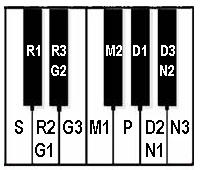Krsna Kirtana Songs
est. 2001 www.kksongs.org
Home
à Music Center à Instrumental Guides à Harmonium Guide
Appendix S6: Carnatic
Ragas
After spending a great deal of time studying the
theory of North Indian music through the harmonium, we began to appreciate its
great degree of usage. We learned in Appendices S4 and S5 of the faults and
limitations of the harmonium. We took the harmonium and try to extract the
harmony from it by understanding chords. After spending time on such a spectrum
in North Indian music, it is important to take a quick
peek in the only genre of music in India that does not use harmonium.
The Carnatic system of
music is the music of South India. This form of music is considered to be the
most purest forms, as it has retained most of its
shape and form, while North Indian music is a fusion between Persian and Vedic
music. By nature, Carnatic music is one of the most
difficult music in the world. One of the many reasons for this is the
complicated note system.
CARNATIC
NOTATION
In the scale, there are twelve unique sounds in
total. However, in Carnatic music, there are also
four notes which are already acknowledged for before. Sa and Pa are immoveable
notes. Ma only comes in two forms. This means, Ri, Ga, Dha, and Ni have more forms
than merely “normal note” and “flat note.” Unfortunately, the theory of how to
derive the notes is beyond the scope of this article. Here is the sixteen note
scale of Carnatic music. Unlike Hindustani music,
numbers are used to mark the positioning of notes.
S
R 1
R 2 , G 1
R
G 3
M 1
M 2
P
D 1
D 2, N 1
D 3, N 2
N 3
Notice how four notes have multiple names. For
instance, R 2 can be called G 1. This is similar to Western music, where D
sharp can be noted as E flat. The both notes sound exactly the same, but
functionality is totally different.
The Vedic names for the sixteen notes go as follows.
S = Sadjamam (Tonic)
R 1 = Suddha Risabham (Lowest Ri)
R 2 = Catusruti Risabham (Fourth microtone Ri) same as G 1
R 3 = Satasruti Risabam (Highest microtone Ri) same as G 2
G 1 = Suddha Gandharam (Lowest Ga) same as R 2
G 2 = Sadharana Gandharam (Ordinary Ga) same as R 3
G 3 = Antara Gandharam (Cadenced Ga)
M 1 = Suddha Madhayamam (Lowest ma)
M 2 = Prati Madhyamam (Augmented ma)
P = Pancham (Fifth or Pa)
D 1 = Suddha Dhaivatam (Lowest Dha)
D 2 = Catusruti Dhaivatam (Fourth microtone Dha) same as N 1
D 3 = Satasruti Dhaivatam (Highest microtone Dha)
same as N 2
N 1 = Suddha Nisadam (Lowest Ni) same
as D 2
N 2 = Kaisiki Nisadam (Middle Ni) same
as D 3
N 3 = Kakali Nisadam (Highest Ni)
Like with Hindustani music, notes in higher or lower
octaves will receive an apostrophe (‘) in front of or behind the note,
respectively.
This is the general scope of Carnatic
musical notation. See Figure S6.1 for a graphical view of this concept.

Figure S6.1
Since more possibilities of notes form, due to a
particular frequency belonging to a different swarasthana,
more ragas can be formed. Their system of ragas is much more complex than North
Indian system. While ten parent scales (thāts)
and over one hundred ragas are known to the North Indian musicians, South
Indian musicians recognize seventy-two parent scales (melakartas,
South Indian equivalent of thāt) and over five
thousand ragas.
Since the Carnatic system
has real notes that can be represented on the keyboard, why is the South Indian
system not picking up the harmonium? The question lies in purity of the music
itself. It has been shown before that the harmonium is based on an
equally-tempered scale. In reality, the twelve notes are not equidistant. It is
the first reason why Carantic musicians reject
harmonium; it cannot accompany their voice to the best extent. Even if it did,
then it will not cut the high standards of mimicking the human voice. The gamaks, minds, and other complex vocal ornamentation cannot
be reproduced by the harmonium.
UPDATED: June 18, 2009
